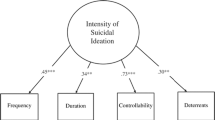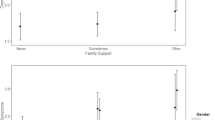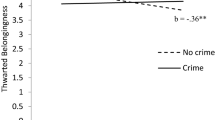Abstract
The role of positive and negative social exchanges between adolescents, their peers and family as predictors of suicide ideation was investigated in a national random sample of 1591 adolescents from the US National Comorbidity Survey. Four indexes measured socio-emotional exchanges by type (positive or negative) and by source (family or peers). Negative exchanges with family were associated with increased suicide ideation scores in younger (15–17) but not in older (18–19) adolescents. Positive support provided as significant buffering effect that was age-specific and independent of gender, income or mood disorders. Providers, especially social workers need to identify both positive and negative exchanges that adolescents experience with family and peers.
Similar content being viewed by others
References
Allison, S., Roeger, L., Martin, G., & Keeves, J. (2001). Gender differences in the relationship between depression and suicidal ideation in young adolescents. Australian and New Zealand Journal of Psychiatry, 35(4), 498–503.
Bae, S., Ye, R., Chen, S., Rivers, P. A., & Singh, K. P. (2005). Risky behaviors and factors associated with suicide attempt in adolescents. Archives of Suicide Research, 9(2), 193–202.
Beautrais, A. L. (2000). Risk factors for suicide and attempted suicide among young people. The Australian and New Zealand Journal of Psychiatry, 34(3), 420–436.
Beautrais, A. L. (2003). Suicide and serious suicide attempts in youth: A multiple-group comparison study. American Journal of Psychiatry, 160(6), 1093–1099.
Blair-West, G. W., Cantor, C. H., Mellsop, G. W., & Eyeson-Annan, M. L. (1999). Lifetime suicide risk in major depression: Sex and age determinants. Journal of Affective Disorders, 55(2–3), 171–178.
Blum, R. W., Beuhring, T., Shew, M. L., Bearinger, L. H., Sieving, R. E., & Resnick, M. D. (2000). The effects of race/ethnicity, income, and family structure on adolescent risk behaviors. American Journal of Public Health, 90(12), 1879–1884.
Borowsky, I. W., Ireland, M., & Resnick, M. D. (2001). Adolescent suicide attempts: Risks and protectors. Pediatrics, 107(3), 485–493.
Brent, D. A., Moritz, G., Bridge, J., Perper, J., & Canobbio, R. (1996). The impact of adolescent suicide on siblings and parents: A longitudinal follow-up. Suicide and Life-threatening Behavior, 26(3), 253–259.
Brown, B. B., Mounts, N., Lamborn, S. D., & Steinberg, L. (1993). Parenting practices and peer affiliation in adolescence. Child Development, 64, 467–482.
Centers for Disease Control. (1998). Suicide among black youths, United States, 1980–95. Morbidity & Mortality Weekly Report, 47(10), 193–169.
Crosnoe, R., & Needham, B. (2004). Holism, contextual variability, and the study of friendships in adolescent development. Child Development, 75(1), 264–279.
Delfabbro, P., Winefield, T., Trainor, S., Dollard, M., Anderson, S., Metzer, J., et al. (2006). Peer and teacher bullying/victimization of South Australian secondary school students: Prevalence and psychosocial profiles. British Journal of Educational Psychology 76(Pt 1), 71–90.
Doddakashi, V., Wilcox, R. E., & Hauser, L. A. (2003). Female suicides in major Texas cities, 1994 through 1998. Texas Medicine, 99(7), 50–58.
Donald, M., Dower, J., Correa-Velez, I., & Jones, M. (2006). Risk and protective factors for medically serious suicide attempts: A comparison of hospital-based with population-based samples of young adults. The Australian and New Zealand journal of psychiatry, 40(1), 87–96.
Doshi, A., Boudreaux, E. D., Wang, N., Pelletier, A. J., & Camargo, C. A., Jr. (2005). National study of US emergency department visits for attempted suicide and self-inflicted injury, 1997–2001. Annals of Emergency Medicine, 46(4), 369–375.
Evans, E., Hawton, K., & Rodham, K. (2004). Factors associated with suicidal phenomena in adolescents: A systematic review of population-based studies. Clinical Psychological Review, 24(8), 957–979.
Finch, J. F., Okun, M. A., Barrera, M., Jr., Zautra, A. J., & Reich, J. W. (1989). Positive and negative social ties among older adults: Measurement models and the prediction of psychological distress and well-being. American Journal of Community Psychology, 17(5), 585–605.
Garnefski, N., & Doets, T. (2000). Perceived social support and dysfunctioning in “clinical” and “normal” adolescents. Journal of Adolescence, 23(6), 753–762.
Gururaj, G., Isaac, M. K., Subbakrishna, D. K., & Ranjani, R. (2004). Risk factors for completed suicides: A case-control study from Bangalore, India. Injury Control and Safety Promotion, 11(3), 183–191.
Gutierrez, P. M., Muehlenkamp, J. J., Konick, L. C., & Osman, A. (2005). What role does race play in adolescent suicidal ideation? Archives of Suicide Research, 9(2), 177–192.
Hollis, C. (1996). Depression, family environment, and adolescent suicidal behavior. Journal of the American Academy of Child and Adolescent Psychiatry, 35(5), 622–630.
Hough, E. S., Brumitt, G. A., & Templin, T. N. (1999). Social support, demands of illness, and depression in chronically ill urban women. Health Care of Women International Journal, 20(4), 349–362.
Ingersoll-Dayton, B., Morgan, D., & Antonucci, T. (1997). The effects of positive and negative social exchanges on aging adults. Journals of Gerontology. Series B, Psychological Sciences and Social Sciences, 52(4), S190–S199.
Institute of Medicine. (2002). Reducing suicide: A national imperative. Washington: The National Academies Press.
Kessler, R. C., Nelson, C. B., McGonagle, K. A., Liu, J., Swartz, M., & Blazer, D. G. (1998). Comorbidity of DSM-III-R major depressive disorder in the general population: Results from the US national comorbidity survey. British Journal of Psychiatry, 168(30), 17–30.
Kessler, R. C., Shanyang, Z., Blazer, D. G., & Swartz, M. (1997). Prevalence, correlates, and course of minor depression and major depression in the national comorbidity survey. Journal of Affective Disorders, 45, 19–30.
Lewinsohn, P. M., Rohde, P., Seeley, J. R., & Baldwin, C. L. (2001). Gender differences in suicide attempts from adolescence to young adulthood. Journal of the American Academy of Child and Adolescent Psychiatry, 40(4), 427–434.
Lunsky, Y., & Benson, B. (2001). Association between perceived social support and strain, and positive and negative outcome for adults with mild intellectual disability. Journal of Intellectual Disability Research, 45(Pt 2), 106–114.
Mazza, J. J., & Reynolds, W. M. (1998). A longitudinal investigation of depression, hopelessness, social support, and major and minor life events and their relation to suicidal ideation in adolescents. Suicide & Life-Threatening Behavior, 28(4), 358–374.
Meadows, L. A., Kaslow, N. J., Thompson, M. P., & Jurkovic, G. J. (2005). Protective factors against suicide attempt risk among African American women experiencing intimate partner violence. American Journal of Community Psychology, 36(1–2), 109–121.
Miller, M., Azrael, D., & Hemenway, D. (2002). Household firearm ownership and suicide rates in the United States. Epidemiology, 13(5), 517–524.
NASW. (2001). NASW News—72 percent work for private organizations.
Newman, B. M., & Newman, P. R. (1999). Early Adolescence (12–18 years). Development through life: A psychosocial approach (7th ed.) (pp. 303–347). Belmont, CA: Wadsworth.
Newsom, J. T., Nishishiba, M., Morgan, D. L., & Rook, K. S. (2003). The relative importance of three domains of positive and negative social exchanges: A longitudinal model with comparable measures. Psychology and Aging, 18(4), 746–754.
Norbeck, J. S., & Anderson, N. J. (1989). Psychosocial predictors of pregnancy outcomes in low-income black, Hispanic, and white women. Nursing Research, 38(4), 204–209.
Pelkonen, M., & Marttunen, M. (2003). Child and adolescent suicide: Epidemiology, risk factors, and approaches to prevention. Paediatric Drugs, 5(4), 243–265.
Plunkett, A., O’Toole, B., Swanston, H., Oates, R. K., Shrimpton, S., & Parkinson, P. (2001). Suicide risk following child sexual abuse. Ambulatory Pediatrics, 1(5), 262–266.
Randell, B. P., Eggert, L. L., & Pike, K. C. (2001). Immediate post intervention effects of two brief youth suicide prevention interventions. Suicide & Life-threatening behavior, 31(1), 41–61.
Reinhardt, J. P. (2001). Social Support and Well-Being in Later Life: Studying the Negative With the Positive. Applied Developmental Science, 5, 66–67.
Robbins, S., Chatterjee, P., & Canda, E. (1998). Behaviorism, social learning, and exchange theory. Comtemporary human behavior theory: A critical perspective for social work (pp. 321–358). Needham Heights: Allyn & Bacon.
Roberts, R. E., Chen, Y. R., & Roberts, C. R. (1997). Ethnocultural differences in prevalence of adolescent suicidal behaviors. Suicide & Life-Threatening Behavior, 27(2), 208–217.
Samaan, R. A. (2000). The influences of race, ethnicity, and poverty on the mental health of children. Journal of Health Care for the Poor and Underserved, 11(1), 100–110.
Steinberg, L., & Duncan, P. (2002). Work Group IV: Increasing capacity of parents, families, and adults living with adolescentes to improve adolescent health outcomes. Society for Adolescent Medicine, 31, 261–263.
Teplin, L. A., McClelland, G. M., Abram, K. M., & Mileusnic, D. (2005). Early violent death among delinquent youth: A prospective longitudinal study. Pediatrics, 115(6), 1586–1593.
Thompson, E. A., Eggert, L. L., & Herting, J. R. (2000). Mediating effects of an indicated prevention program for reducing youth depression and suicide risk behaviors. Suicide & Life-Threatening Behavior, 30(3), 252–271.
U.S. Public Health Service. (1999). The surgeon general’s call to action to prevent suicide. Washington: Department of Health and Human Services.
van der Wal, M. F. (2005). There is bullying and bullying. European Journal of Pediatrics, 164(2), 117–118.
Vaughn, A. A., & Roesch, S. C. (2003). Psychological and physical health correlates of coping in minority adolescents. Journal of Health Psychology, 8(6), 671–683.
Vieweg, W. V., Linker, J. A., Anum, E. A., Turf, E., Pandurangi, A. K., Sood, B., et al. (2005). Child and adolescent suicides in Virginia: 1987 to 2003. Journal of Child and Adolescent Psychopharmacology, 15(4), 655–663.
Wingate, L. R., Bobadilla, L., Burns, A. B., Cukrowicz, K. C., Hernandez, A., Ketterman, R. L., et al. (2005). Suicidality in African American men: The roles of southern residence, religiosity, and social support. Suicide & Life-Threatening Behavior, 35(6), 615–629.
Woods, E. R., Lin, Y. G., Middleman, A., Beckford, P., Chase, L., & DuRant, R. H. (1997). The associations of suicide attempts in adolescents. Pediatrics, 99(6), 791–796.
Author information
Authors and Affiliations
Corresponding author
Rights and permissions
About this article
Cite this article
Bertera, E.M. The Role of Positive and Negative Social Exchanges Between Adolescents, their Peers and Family as Predictors of Suicide Ideation. Child Adolesc Soc Work J 24, 523–538 (2007). https://doi.org/10.1007/s10560-007-0104-y
Received:
Accepted:
Published:
Issue Date:
DOI: https://doi.org/10.1007/s10560-007-0104-y




